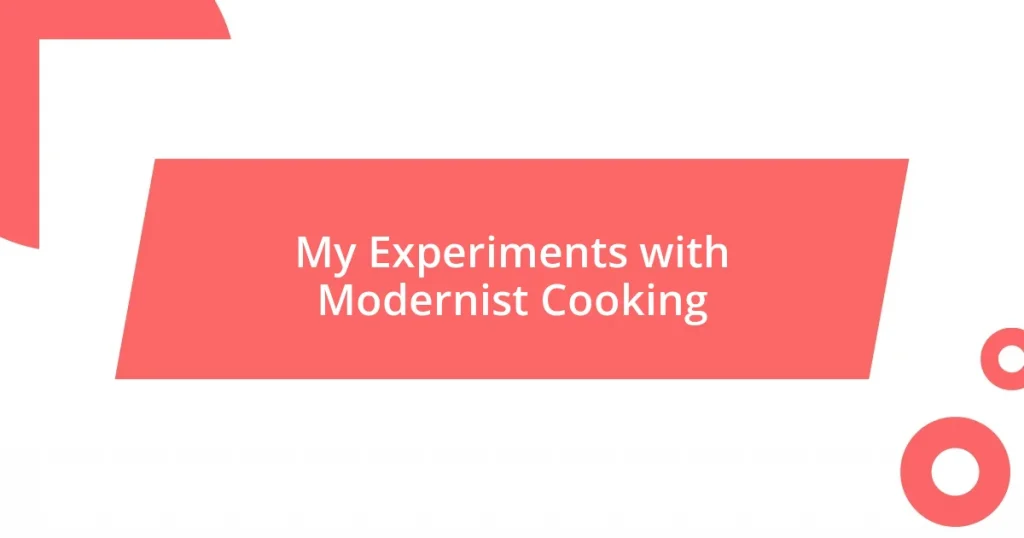Key takeaways:
- Modernist cooking blends science and art, transforming traditional culinary methods through innovative techniques like sous vide, spherification, and emulsification.
- The right equipment, such as immersion circulators and siphons, is essential for exploring modernist techniques and enhancing the cooking experience.
- Successful modernist cooking requires precision, creativity in presentation, and a willingness to experiment with textures to create memorable dining experiences.

Introduction to Modernist Cooking
Modernist cooking is a fascinating culinary movement that pushes the boundaries of traditional food preparation methods. I remember the first time I stumbled upon a molecular gastronomy dish; it was as if I was experiencing food for the first time all over again. Have you ever tasted a burst of flavors encapsulated in a tiny sphere? That playful combination of science and art in the kitchen sparked a passion in me to explore the techniques and philosophies that define this approach.
At its core, modernist cooking embraces the idea that food can be transformed not just in flavor but also in texture and presentation through innovative techniques. When I first tried sous vide cooking, a method of vacuum-sealing food and cooking it at precise temperatures, I was amazed at how it could turn a simple piece of meat into a tender, juicy masterpiece. Have you ever had such a powerful food experience that it changed the way you look at cooking?
Delving deeper into this culinary world, I discovered how ingredients could be manipulated to create entirely new sensations—like those air foams and flavored gels that play with your expectations of what food should be. It’s exciting to think about how scientists and chefs collaborate to unlock flavors and textures we never knew existed. What are the secrets behind these techniques, and how can they elevate our home cooking? Each exploration into modernist cuisine brings not just knowledge but also a sense of creativity that can invigorate our cooking adventures.

Key Techniques in Modernist Cuisine
Sous vide, one of the most celebrated techniques in modernist cuisine, involves cooking food in a vacuum-sealed bag immersed in a water bath at a precisely controlled temperature. I distinctly remember my first attempt with sous vide; the steak emerged perfectly cooked—medium-rare throughout, an absolute revelation! It was surprising to realize how such a simple method could produce such tender and flavorful results that I had previously only dreamed of achieving.
Another exciting aspect of modernist cooking is spherification, which creates those delightful flavor-filled spheres. I had the opportunity to try this technique during a workshop, and witnessing my first caviar-like burst of a fruit puree was nothing short of magical. The delightful surprise of flavor exploding in my mouth left me grinning from ear to ear and inspired to experiment further in my own kitchen.
Emulsification is also pivotal in modernist cuisine, allowing us to create unique sauces with an astonishingly smooth texture. I recall my excitement while whipping up a flavorful foam using lecithin. The enhanced taste and texture it added to my dish left my diners raving. This creativity allows culinary artists to redefine the dining experience, transforming simple meals into extraordinary works of art.
| Technique | Description |
|---|---|
| Sous Vide | Cooking food in a vacuum-sealed bag at controlled temperatures in a water bath. |
| Spherification | Creating flavor-filled spheres that burst in the mouth with a delightful surprise. |
| Emulsification | Combining ingredients to create smooth sauces and foams, elevating textures. |

Essential Equipment for Modernist Cooking
When diving into modernist cooking, having the right equipment is essential. For me, investing in quality tools transformed my culinary experience. The way they facilitate innovative techniques is remarkable. It’s like having a secret weapon in the kitchen, enabling you to create dishes that surprise and delight. Here’s a list of must-have equipment that can help elevate your modernist cooking endeavors:
- Immersion Circulator: A staple for sous vide cooking, ensuring precise temperature control to achieve perfect doneness.
- Siphon: This device allows you to create airy foams and infusions, adding unique textures and flavors to your dishes.
- Anti-griddle: A fantastic tool for rapid freezing that allows you to create stunning, frozen textures right before serving, adding an element of surprise.
- Precision Scale: This is crucial for accurately measuring ingredients, especially when working with chemicals and powders in modernist techniques.
- Blender: A high-speed blender is essential for emulsifying and smoothening sauces or creating innovative purées.
- Gelification Tools: Items like agar agar or gelatin allow you to experiment with textures, transforming liquids into gels or jellies.
The thrill of using each piece of equipment for the first time is something I’ll never forget. Once, while using my siphon for the first time, I created a lemon foam that elevated a simple dessert to a new level. Watching my guests’ reactions as they experienced that unexpected burst of flavor was a joyous moment. It’s these connections—between tools, techniques, and the people I share them with—that make modernist cooking an enriching journey.

Experimenting with Sous Vide Method
Experimenting with the sous vide method has truly been a game changer for me in the kitchen. One night, after a long day, I decided to try cooking a pork chop using sous vide. I set the immersion circulator to 140°F and let it cook for two hours while I relaxed. When I finally plated it up, the chop was so juicy and tender that I couldn’t help but think, “Why didn’t I try this sooner?” The hands-off aspect made me realize the beauty of sous vide—it allows for perfect textures without the stress of timing.
Another memorable experience was when I experimented with vegetables. I vacuum-sealed a mix of carrots, zucchini, and asparagus with just a hint of olive oil and sea salt, setting the temperature to 183°F. When they finished cooking, I was amazed at how vibrant and full of flavor they turned out. Each vegetable was perfectly cooked—not mushy but still with a pleasing bite. It dawned on me that sous vide takes out the guesswork, and I felt like I could elevate simple ingredients into something extraordinary.
I find it fascinating to think about how sous vide appeals to the idea of scientific precision in cooking. Have you ever wondered what it would be like to cook a dish precisely as it should be every single time? With sous vide, it feels like you’re embracing a level of control that simply isn’t possible with traditional methods. It’s almost like alchemy—transforming food into its best possible version just by controlling the temperature.

Understanding Molecular Gastronomy
Understanding molecular gastronomy opens a fascinating door to the science behind cooking. It merges culinary art with chemistry, allowing us to explore textures and flavors in ways we never thought possible. For example, I remember my first attempt at spherification, where I created small citrus pearls that burst in the mouth. The joy of seeing those little spheres defy my expectations was thrilling and made me appreciate the science behind food even more.
When I first encountered the concept of emulsification in molecular gastronomy, I believed it was just about mixing oil and water. But as I experimented with techniques, particularly using a stabilizing agent, I realized that the texture and mouthfeel of sauces could be completely transformed. It was like uncovering a new layer to flavor that I never knew existed. Have you ever marveled at how a simple vinaigrette could go from thin and runny to thick and creamy? That’s the magic of molecular gastronomy at work.
The use of modernist techniques has elevated my cooking in unexpected ways. I can still remember the exhilaration I felt when I added powdered celery to a cream sauce, which not only intensified the flavor but also enhanced its color. That moment made me realize how molecular gastronomy encourages us to view ingredients in a new light. I often find myself pondering: what if I could infuse a dessert with the essence of lavender using unexpected methods? The fun lies in continually questioning and redefining what cooking can be.

Creative Presentation of Dishes
Presentation is often the first thing that captures attention when serving a dish, and I’ve found that a little creativity can elevate the entire dining experience. One evening, I decided to serve a simple tomato soup, but instead of a regular bowl, I poured it into a clear glass. Would you believe that the colors and textures danced within that glass? It transformed a humble dish into an eye-catching centerpiece that sparked conversation at the table.
I’ve also dabbled in the art of plating, using sauces not just as a component but as part of the artwork itself. Picture this: I took a white plate and created sweeping brushstrokes of basil oil, then placed a delicate piece of grilled fish at the center, garnished with a few edible flowers. The contrast between the vibrant green and the pale fish was striking—almost like painting on a canvas. I couldn’t help but smile as my guests intriguedly leaned in closer to inspect the plate, their anticipation building with each glance.
There’s something deeply satisfying about presenting food in a way that tells a story. One time, I served a dessert that resembled a miniature garden, with almond soil, chocolate rocks, and mint leaves for trees. I watched as everyone marveled at the details, momentarily forgetting that they were just about to eat it! It prompts me to ask, how often do we consider our meals as an experience worthy of exploration? Creative presentation invites us to engage deeper with our food, transforming a simple meal into an art form and a memorable moment.

Tips for Successful Modernist Cooking
When diving into modernist cooking, accuracy is paramount. I learned this the hard way during my first sous vide experiment, where precise temperature control turned a tough cut of meat into an unbelievably tender meal. Have you ever cooked something only to realize it was overdone or undercooked? Honestly, measuring with a reliable thermometer transforms uncertainty into confidence, which allows you to explore more daring dishes without fear of failure.
Additionally, don’t shy away from experimenting with new textures. I recall attempting to create a foamy raspberry topping using a siphon. It was a bit messy, but the sheer delight on my friends’ faces when they took their first bite was priceless. This experience taught me that embracing playful experimentation is essential. Why not take a leap and try something you’ve never considered before? You never know—your next culinary masterpiece could be just one adventurous step away.
Lastly, I’d recommend keeping a journal of your modernist creations. I started this practice after a particularly satisfying meal where I combined flavors that surprised my palate. Documenting not just the recipes but also my thoughts and feelings during the process has been invaluable. Have you ever forgotten the details of a dish you loved? Writing it down preserves those fleeting moments of inspiration, ensuring you can replicate them or even build upon them in your future culinary explorations.















